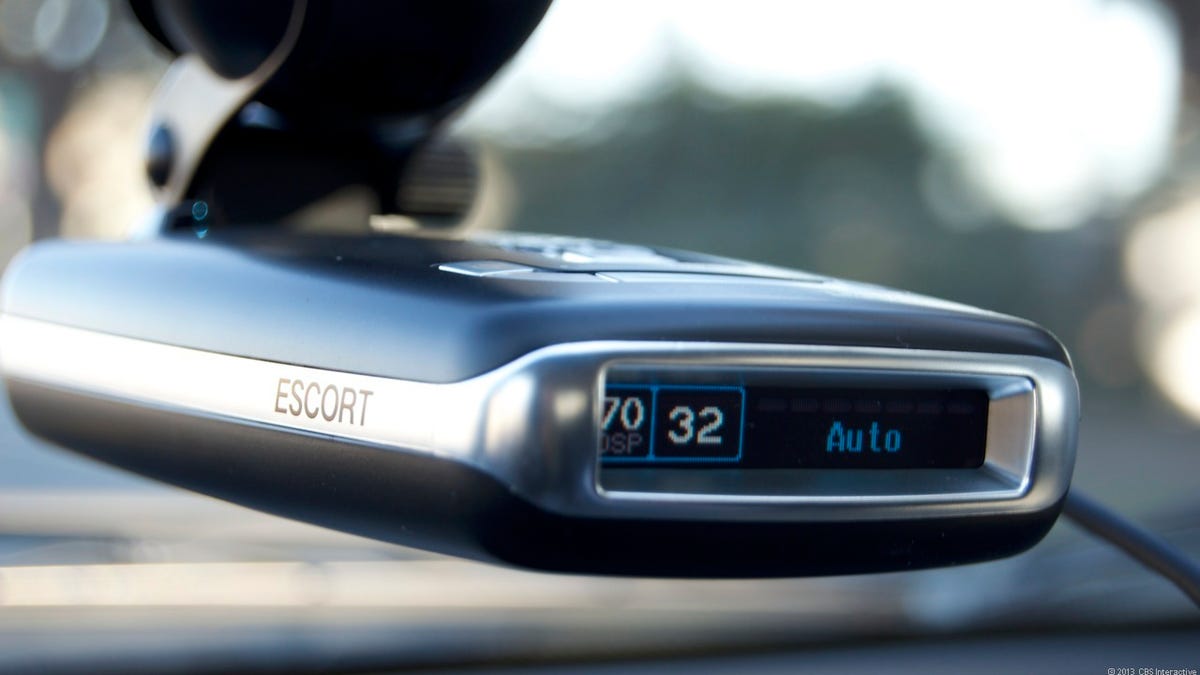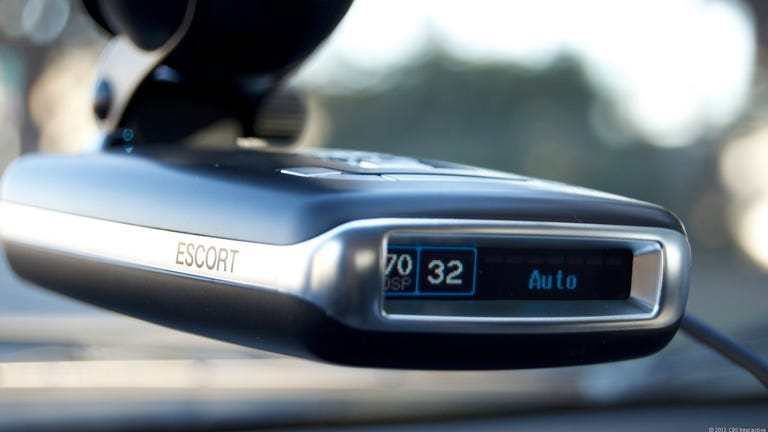 Why You Can Trust CNET
Why You Can Trust CNET Escort Passport Max review: Escort detector boasts more signal, less noise
Escort's Passport Max brings few new tricks to the radar detector's bag of tricks, including GPS connectivity and DSP processing.
Escort's Passport Max brings few new tricks to the radar detector's bag of tricks. It's got GPS connectivity, which it uses in some innovative ways. It uses new signal-processing tech to tune out the noise that triggers false alerts. It's even got a new suction cup.
The Good
The Bad
The Bottom Line
Design
The Passport Max attaches to your car's windshield with a new Sticky Cup suction mount, similar to that of the Bracketron Mi-T Grip. While it looks like a standard lever-activated suction cup, the Sticky Cup uses a tacky, indeed, sticky semiadhesive material for its cup. With this change, the Passport sacrifices a bit of liberty for security, as the new suction cup is less forgiving during positioning (as it sticks to rather than slides on glass and has only one hinged point of articulation) and is more difficult to remove, but holds to the windshield glass with great strength.
Escort refers to the Passport Max as "compact" but at 1.3 by 3.2 by 5.3 inches, it feels pretty big to me. Imagine about three Nexus 4s stacked sandwich-style, and you'll have an idea of its size. Still, size doesn't really matter here, as the Max isn't really the kind of thing that you'd carry around all day, though it does ship with a nice soft carrying case for it and its accessories.

Crammed into the chassis and peeking from behind tinted plastic on the front of the device, you'll find the sensors for the Passport Max's radar and laser detection. Atop the device, you'll also find a second, rear-facing laser detector periscoping out of the chassis.
The top is also where you'll find buttons for mute, power, marking a threat, volume, sensitivity, and brightness, many of which pull double duty.
The back of the device, which points at you, the driver, is home to a thin, full-color OLED display rather than the standard LED matrix. Here is where the Passport will share information about its operation with the driver. The interface features adjustable backlight level and color controls.
Supplying power to the Max is the SmartCord, which integrates the 12-volt power connector, lights indicating power on and alert detected, and a mute button. The mute button performs a few hidden functions that we'll return to momentarily, but primarily it's there so you won't have to stretch all of the way to the windshield to shut off an alert while driving, which can be difficult, even impossible, in some cars. The SmartCord connects to the Passport Max with what looks like an RJ-11 telephone connection, allowing it a bit of bidirectional communication.
Next to the SmartCord connection on the passenger's side of the device, you'll also find a Mini-USB connection for firmware and database updates (though a USB cable was not included in the box), and a headphone jack to output audio prompts (both beeps and spoken words). Perhaps you'd like to connect the Max to your car stereo's auxiliary input? This is where you'd plug in.
GPS-enabled, so it knows your speed
On the top of the Passport Max, just ahead of the Mute button, are engraved the letters "GPS." No, the radar detector won't navigate you home, but its connection to the global positioning system affords it a few advantages over your average detector.
Firstly, it knows how fast you're going. You can set, in a menu, an OSP Over Speed Alert, which is a maximum speed that you don't want to exceed. Drive more than a few miles per hour faster and the Max will beep and speak the words, "Reduce speed." This is a nice, proactive way to avoid tickets by simply not letting your speed get away from you.
With its Variable Speed Sensitivity, the Max is also able to tailor its sensitivity to the sort of driving the vehicle is actually doing. At highway speeds, it can optimize for long-range sensitivity, while at slower speeds, the sensitivity can be adjusted to tune out more false positives, since you're not at risk of getting a speeding ticket. I noticed that even the sound of the alerts are different: there's only a short double-chirp for alerts at speeds below than 20 mph.
Also, the Max knows where you are. Loaded on the device is Escort's Defender database of red-light and speed cameras. As you approach one of these hazards, the detector will beep at you and say, "Speed camera ahead." The Defender database can be updated weekly by connecting the Max to your Web-connected computer.
The system is also able to "AutoLearn" where false positives (like door openers or those fixed-position speed signs) are and can automatically record their position and learn to ignore them over time.
On-the-road testing
The Passport Max debuts a new Digital Signal Processing technology -- which is supposedly borrowed from military tech, but sounds a lot like audio DSP technology reapplied. By processing the RF signals detected by the Max's sensors, the detector is able to essentially tune out the noise, separating "real radar threats" from RF interference and false positives for improved accuracy.
The Max is also equipped with Traffic Sensor Rejection (TSR) software, which can automatically ignore radar pings from wireless traffic sensors used on certain highways.
Working in tandem with the loaded Defender database and AutoLearn, the Passport Max's DSP should only beep for real threats, once you've given it ample time to learn your area.
During my testing, I only ran into a few false alerts -- including a pair of prolonged bursts of K band detection and a handful of chirps for X band here and there -- but largely the system was blissfully quiet, even as I trolled around areas with automatic door openers that I know usually trigger false positives.
Because the Max only has a rough idea of where you are, and doesn't include maps, it would sometimes give audible alerts for approaching red-light cameras on surface roads when driving on an adjacent highway, which was annoying, but not a deal breaker. I'd rather have a few unneeded alerts than end up with a ticket for coasting through on yellow.
Whenever the Max starts beeping, a selectable AutoMute function lowers the volume automatically after a second or two to keep the detector from being too obnoxious once it's grabbed your attention. Of course, tapping the Mute button on the SmartCord will allow you to manually shut it up.
A feature called SmartMute allows drivers to manually mark false alarms by triple-tapping the Mute button on the SmartCord when alerted. You'll still see notifications for these detections on the screen the next time you pass the false threat, but you won't hear the beeping. If, later, a false threat turns out to be real, double-tapping will remove it from the Max's false-positive database.
I had the hardest time finding an actual police officer clocking speed, so I fired up Escort's Escort Live and went speed trap hunting. After many miles, I finally approached a prospective speed trap and was pleased to hear the Passport Max light up and start chirping, just a few moments before my "control group" radar detector, the Escort SmartRadar, did. Repeating the experiment at a few speed traps around the Bay Area over the course of a few weeks yielded similar results: the Passport Max was more sensitive than Escort's previous generation of detectors.
We'll keep testing the Max over the next few weeks in a variety of municipalities and will update the review with any new findings.
Escort Live app
Take a look at the Passport Max's box and you'll notice two things. First, the Max is depicted displaying the current speed limit. Secondly, it's touted as being compatible with the Escort Live app for Android or iOS.
However, flip the box over and read the fine print and you'll see that to gain this app compatibility, you'll need to purchase a $99.99 Escort SmartCord Live, which replaces the included SmartCord and adds the Bluetooth connectivity that you'll need to make the wireless connection.
With the SmartCord Live in place, your smartphone paired, and the app downloaded and running, the Passport Max gains a few new tricks.
Firstly, users can adjust the Max's settings via the paired phone's touch screen, which can be much easier than fiddling with the device's handful of buttons and tiny screen.
Additionally, the phone's data connection feeds live-updating Defender database data with up-to-the-minute positioning for speed traps, speed cameras, red-light cameras, and more to the Passport Max, allowing it to automatically ignore false positives reported by other Defender database-reporting drivers. Likewise, any speed traps detected by the Max are automatically reported to the Defender database, without you needing to press any buttons.
Additionally, to get the current speed limit data, you'll need the app's data connection.
The $99.99 SmartCord Live is specific to Android or iOS, so you'll need to decide which platform you're using. Presumably, you'll need two cables if you live in a cross-platform household.
In sum
The Escort Live app only includes a few days of free access to the Defender database, so you'll need to additionally pay a monthly or annual subscription to retain access. That's $4.99 per month or $49.99 per year on top of the $99.99 for the cable, which really should be tossed in for free with the Passport Max's $549.95 MSRP. Unless you live in an area where the coppers are particularly tricky with their speed traps, I'm not sure that the connected part of this equation is worth the dough.
Judged as a standalone product, however, the Passport Max impressed me with its easy-to-understand OLED-based interface, its ability to detect threats earlier than the previous generations, and its ability to tune out those false positives that make radar detectors so annoying to use on a daily basis. With an MSRP that, coincidentally, matches the amount of the largest speeding ticket that I've ever received, I can't say that the Passport Max is a bargain, but it certainly justifies its price tag.


